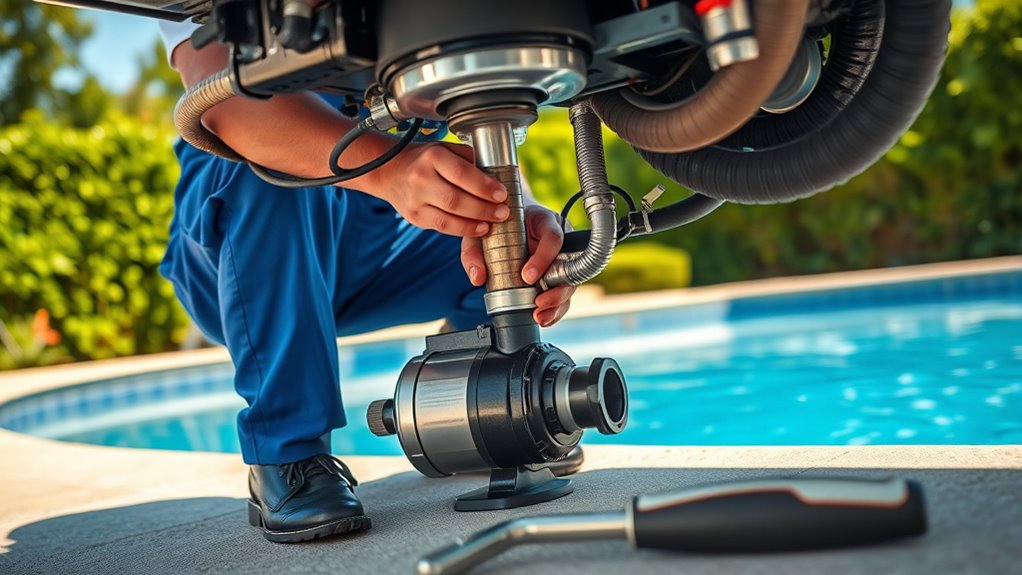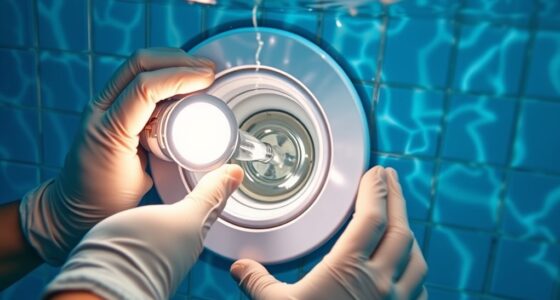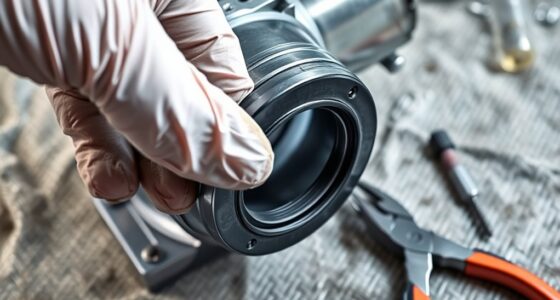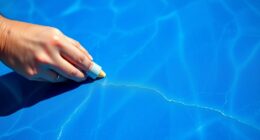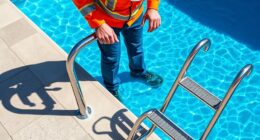If your pool pump is making noise, start by turning it off and inspecting the motor and bearings for damage or debris. Lubricate the bearings if they’re worn, or replace them if they’re severely damaged. Check the pump’s alignment and secure all bolts and brackets to prevent vibrations. Addressing these issues promptly can quiet the noise and extend your pump’s life. Keep going, and you’ll discover more tips to solve the problem effectively.
Key Takeaways
- Turn off the pump and inspect bearings for damage, debris, or lack of lubrication.
- Lubricate minor bearing noises with water-resistant, high-quality lubricant; replace damaged bearings as needed.
- Check motor alignment, tighten loose bolts, and ensure the pump shaft is straight.
- Remove debris, inspect seals, and verify all mounting components are secure.
- Regularly maintain and inspect the pump to prevent bearing wear and ensure quiet, reliable operation.

A noisy pool pump can disrupt your outdoor space and signal underlying problems that need attention. One of the most common causes of noise is issues within the pump motor, particularly bearing noise. When your pump starts making grinding, squealing, or rattling sounds, it’s often due to worn or damaged bearings inside the motor. Bearings are essential for smooth operation, supporting the motor shaft and reducing friction. Over time, they can wear out due to constant use, lack of lubrication, or debris entering the motor. When this happens, the noise becomes more pronounced, and the pump’s efficiency declines. Recognizing bearing noise involves listening for a high-pitched squeal or a grinding sound that intensifies when the pump runs longer. If ignored, worn bearings can lead to motor failure, resulting in costly repairs or replacements. Regular maintenance, including inspecting and lubricating bearings, can help prevent these issues before they escalate.
A noisy pool pump often signals worn bearings causing grinding or squealing sounds.
To troubleshoot this issue, start by turning off the pump and inspecting the motor housing. Remove the motor cover carefully to access the bearings. If you notice any visible damage, corrosion, or debris, cleaning or replacing the bearings becomes necessary. In many cases, the noise persists because the bearings are simply worn out and need lubrication or replacement. Applying a high-quality, water-resistant lubricant can sometimes quiet minor bearing noise, but if the bearings are severely worn or damaged, replacing them is the best course of action. When replacing bearings, verify you select the correct size and type specified for your pool pump model. Proper installation is essential to prevent future noise and ensure smooth operation.
Another step is to check if the pump motor is properly aligned and securely mounted. Misalignment can cause undue stress on the bearings, leading to noise and premature failure. Tighten any loose bolts or mounting brackets, and confirm that the motor is level and properly aligned with the pump impeller. Additionally, verify that the pump’s shaft isn’t bent or damaged, as this can also contribute to bearing noise. If debris or dirt has entered the motor, cleaning out the motor housing and ensuring that all seals and gaskets are intact can prevent further contamination. Regular maintenance, including lubrication and cleaning, is crucial for preventing bearing failure and extending the lifespan of your pump.
Addressing bearing noise early on will not only quiet your pool area but also extend the lifespan of your pump, ensuring reliable operation throughout the swimming season.
Frequently Asked Questions
Can a Noisy Pool Pump Damage Other Pool Equipment?
Yes, a noisy pool pump can damage other pool equipment. Excessive pump vibration caused by imbalance or worn parts can lead to motor overheating, which risks damaging the motor and nearby components. Continuous noise often indicates underlying issues, so addressing these early helps prevent costly repairs. Regular maintenance, checking for loose parts, and ensuring proper lubrication can reduce vibration and prevent motor overheating, protecting your entire pool system.
Is It Safe to Operate a Noisy Pump During Maintenance?
Operating a noisy pump during maintenance is like sailing with rough waters—you’re risking further damage. It’s generally unsafe because pump vibration issues can worsen, and noise reduction techniques won’t work effectively. To protect your equipment, turn off the pump before maintenance, then address the noise. Running it while noisy can cause more harm, so wait until repairs are complete for safe, smooth operation.
How Often Should I Inspect My Pool Pump for Noise Issues?
You should inspect your pool pump regularly, ideally once a month, to catch noise issues early. During these routine inspections, focus on noise level monitoring to identify any unusual sounds that could indicate problems. Check for loose parts, debris, or worn-out components. Consistent noise level monitoring helps you maintain ideal pump performance, prevent damage, and ensure your pool operates smoothly without unnecessary noise disruptions.
Are There Eco-Friendly Solutions to Reduce Pool Pump Noise?
Yes, you can reduce pool pump noise eco-friendly by using insulation made from recycled materials, which absorbs sound effectively. Installing noise-reducing covers made from sustainable foam also helps muffle vibrations and noise. Regular maintenance, like tightening fittings and replacing worn parts, complements these solutions. These eco-friendly options not only quiet your pool area but also minimize environmental impact, making your pool more sustainable and enjoyable.
Can a Noisy Pump Indicate a Leak in the System?
A noisy pump can indeed signal a leak in your system, much like a whisper revealing secrets. When you notice unusual pump vibration or hear grinding sounds, check for seal leaks. These leaks can cause vibrations and noise, indicating pressure loss. If you detect a leak, inspecting seals and fittings promptly helps prevent further damage. Addressing these signs early keeps your pool running smoothly and quietly, saving you time and money.
Conclusion
So, now that you’re armed with all these troubleshooting tricks, you can finally silence that relentless pool pump symphony. Imagine yourself peacefully lounging by the water, free from the relentless hum and clatter. No more pretending you’re at a construction site—just pure, tranquil swimming bliss. Who knew fixing a noisy pump could turn you into the hero of your backyard oasis? Now go forth, troubleshoot, and enjoy your serene, noise-free paradise!
